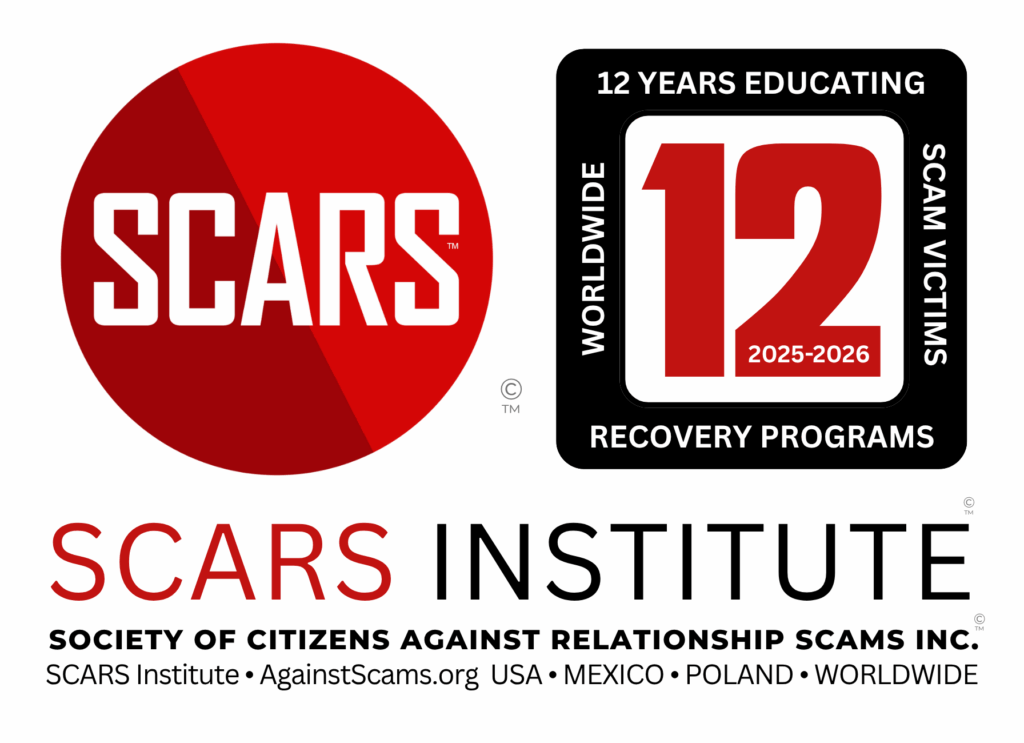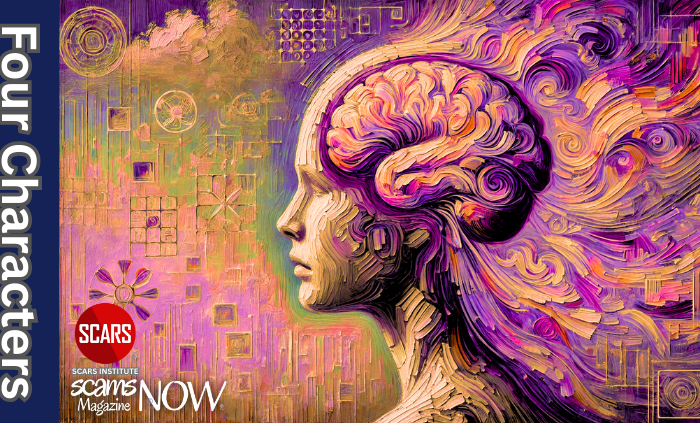Synthetic Pornography – A Growing Danger To The World
A SCARS Editorial
Author:
• SCARS Editorial Team – Society of Citizens Against Relationship Scams Inc.
Photo Credit: Mark Pohlmann
Synthetic Pornography Is Revolutionizing What People Of Particular Tastes Can Have Now, All Through Generative AI
Synthetic porn, also known as deepfake porn, is a type of manipulated media that uses artificial intelligence (AI) to create non-consensual pornography. It typically involves superimposing the face of a non-consenting person onto the body of someone else in a pornographic video, but it can be completely synthetic and generated by AI from nothing but a text description of what is desired.
Synthetic porn can have a devastating impact on real victims when it uses their faces. It can cause them emotional distress, reputational damage, and even physical harm. In some cases, victims have lost their jobs, been ostracized by their communities, and even committed suicide.
In addition to the harm it causes to victims, synthetic porn also poses a threat to society as a whole. It can be used to spread misinformation, damage reputations, and erode trust in institutions. It can also be used to normalize violence against women and girls.
Here are some of the specific dangers of synthetic porn:
- Non-consensual creation: Synthetic porn is created without the consent of the person whose face is being used. This is a violation of their privacy and a form of sexual harassment.
- Emotional distress: Victims of synthetic porn often experience severe emotional distress, including anxiety, depression, and post-traumatic stress disorder (PTSD).
- Reputational damage: Synthetic porn can be shared widely online, causing victims to suffer reputational damage and social isolation.
- Physical harm: In some cases, victims of synthetic porn have been subjected to physical violence and harassment.
- Normalization of violence: Synthetic porn can contribute to the normalization of violence against women and girls.
- Erosion of trust: Synthetic porn can erode trust in institutions and individuals, making it more difficult to address other forms of online abuse.
It is important to take action to address the threat of synthetic porn. This includes:
- Raising awareness: People need to be aware of the dangers of synthetic porn and how to protect themselves and others.
- Developing technology to detect and remove synthetic porn: There is a need for technology that can be used to detect and remove synthetic porn from the internet.
- Creating laws to address synthetic porn: There is a need for laws that make it illegal to create and distribute synthetic porn without the consent of the person whose face is being used.
- Providing support to victims: Victims of synthetic porn need access to support services to help them cope with the emotional and psychological impact of the abuse.
Synthetic porn is a serious problem with far-reaching consequences. It is important to take action to address this issue and protect victims from harm.
Use of Generative AI in Creating Child Porn
Generative AI and the Production of Illegal Child Photos
The rapid advancement of generative AI technologies has raised serious concerns about their potential misuse in the creation of illegal child photos. These AI models, capable of producing realistic and convincing images, are being exploited by individuals to generate child sexual abuse material (CSAM).
One of the primary concerns is the ability of generative AI to create new images of existing victims. By analyzing existing CSAM, these models can learn to generate new images that are indistinguishable from real ones. This can lead to the perpetuation of abuse by creating new instances of victimization.
Furthermore, generative AI can be used to create deepfakes, which are manipulated videos or images that make it appear as if someone is saying or doing something they never did. Deepfakes are particularly dangerous when used to create CSAM, as they can be used to fabricate scenarios of abuse involving real children.
The production of illegal child photos using generative AI poses a significant threat to children’s safety and well-being. It is crucial for law enforcement agencies, technology companies, and policymakers to work together to address this emerging threat.
Measures to Combat the Misuse of Generative AI
Several measures can be taken to combat the misuse of generative AI in the production of illegal child photos:
- Developing AI tools for detecting CSAM: AI can be used to develop tools that can identify and flag CSAM online. This can help in removing illegal content from the internet and preventing its distribution.
- Improving AI education and awareness: Educating AI developers, users, and the general public about the ethical implications of AI can help prevent its misuse.
- Strengthening legal frameworks: Existing laws may need to be updated to address the specific challenges posed by AI-generated CSAM.
- Collaboration between law enforcement, technology companies, and policymakers: Effective collaboration is essential to address this complex issue.
- Promoting responsible AI development: Encouraging the development of AI with built-in safeguards against misuse can help mitigate the risk of harm.
By taking these measures, we can work towards a future where generative AI is used for positive purposes and not for the exploitation of children.
OpEd by Mark Pohlmann, Founder & CEO of Aeteos.com:
Here is Maisie [see post photo]. She is 11 years old. She has been created by AI (Stable Diffusion) 2 weeks ago. Many photos of her are available online. This is what technology can do today. Generate pictures, soft to hardcore pictures of children that are then broadcasted massively on the Internet!
The raw material that those criminals are using to generate those pictures are mainly taken from YOUR social networks because YOU took pictures of your child, doing this, doing that, and thousands of pictures of your children are available on your Instagram or Facebook. Those pictures, those private pictures will be used to generate those images. Be prepared !
Evidences can be found TODAY that tools such as ChatGPT are used to ease the creation of those disgusting images. Because yes, those images are created using a Text to Image technology and ChatGPT can generate many of those very fast.
This is where we are in 2023 and the worst of all is that no action is taken by politicians to STOP this NOW ! So be prepared.
We need to protect our children while they are online, it is a top priority. But we do nothing, as a society to stop this.
Maisie is just one example. On the web you will find thousands of such images, they are just added on a daily basis to fulfill the desire of pedocriminals worldwide.
Strengthening Our Laws Against This
According to AP September 5, 2023:
Prosecutors in all 50 states urge Congress to strengthen tools to fight AI child sexual abuse images
The top prosecutors in all 50 states are urging Congress to study how artificial intelligence can be used to exploit children through pornography, and come up with legislation to further guard against it.
In a letter sent Tuesday to Republican and Democratic leaders of the House and Senate, the attorneys general from across the country call on federal lawmakers to “establish an expert commission to study the means and methods of AI that can be used to exploit children specifically” and expand existing restrictions on child sexual abuse materials specifically to cover AI-generated images.
“We are engaged in a race against time to protect the children of our country from the dangers of AI,” the prosecutors wrote in the letter, shared ahead of time with The Associated Press. “Indeed, the proverbial walls of the city have already been breached. Now is the time to act.”
South Carolina Attorney General Alan Wilson led the effort to add signatories from all 50 states and four U.S. territories to the letter. The Republican, elected last year to his fourth term, told AP last week that he hoped federal lawmakers would translate the group’s bipartisan support for legislation on the issue into action.
“Everyone’s focused on everything that divides us,” said Wilson, who marshaled the coalition with his counterparts in Mississippi, North Carolina and Oregon. “My hope would be that, no matter how extreme or polar opposites the parties and the people on the spectrum can be, you would think protecting kids from new, innovative and exploitative technologies would be something that even the most diametrically opposite individuals can agree on — and it appears that they have.”
The Senate this year has held hearings on the possible threats posed by AI-related technologies. In May, OpenAI CEO Sam Altman, whose company makes free chatbot tool ChatGPT, said that government intervention will be critical to mitigating the risks of increasingly powerful AI systems. Altman proposed the formation of a U.S. or global agency that would license the most powerful AI systems and have the authority to “take that license away and ensure compliance with safety standards.”
While there’s no immediate sign Congress will craft sweeping new AI rules, as European lawmakers are doing, the societal concerns have led U.S. agencies to promise to crack down on harmful AI products that break existing civil rights and consumer protection laws.
In additional to federal action, Wilson said he’s encouraging his fellow attorneys general to scour their own state statutes for possible areas of concern.
“We started thinking, do the child exploitation laws on the books — have the laws kept up with the novelty of this new technology?”
According to Wilson, among the dangers AI poses include the creation of “deepfake” scenarios — videos and images that have been digitally created or altered with artificial intelligence or machine learning — of a child that has already been abused, or the alteration of the likeness of a real child from something like a photograph taken from social media, so that it depicts abuse.
“Your child was never assaulted, your child was never exploited, but their likeness is being used as if they were,” he said. “We have a concern that our laws may not address the virtual nature of that, though, because your child wasn’t actually exploited — although they’re being defamed and certainly their image is being exploited.”
A third possibility, he pointed out, is the altogether digital creation of a fictitious child’s image for the purpose of creating pornography.
“The argument would be, ‘well I’m not harming anyone — in fact, it’s not even a real person,’ but you’re creating demand for the industry that exploits children,” Wilson said.
There have been some moves within the tech industry to combat the issue. In February, Meta, as well as adult sites like OnlyFans and Pornhub, began participating in an online tool, called Take It Down, that allows teens to report explicit images and videos of themselves from the internet. The reporting site works for regular images and AI-generated content.
“AI is a great technology, but it’s an industry disrupter,” Wilson said. “You have new industries, new technologies that are disrupting everything, and the same is true for the law enforcement community and for protecting kids. The bad guys are always evolving on how they can slip off the hook of justice, and we have to evolve with that.”
Curb the Misuse of Generative AI in Producing Synthetic Images of Children
The rapid advancement of generative AI technologies has brought about a plethora of potential benefits, revolutionizing various industries and aspects of our lives. However, this powerful technology also carries inherent risks, particularly in the realm of child exploitation. The ability of generative AI to produce hyper-realistic synthetic images of children raises serious concerns about its potential misuse in creating and distributing child sexual abuse material (CSAM).
The Threat Posed by Synthetic CSAM
The production of synthetic CSAM using generative AI poses a significant threat to children’s safety and well-being in several ways:
- Perpetuation of Abuse: Generative AI can be used to create new images of existing victims, replicating and perpetuating their abuse. This can cause further trauma and distress to the victims and their families.
- Fabrication of Abuse: Deepfakes, manipulated videos or images created using generative AI, can be used to fabricate scenarios of abuse involving real children. This can damage the reputation of innocent children and cause immense emotional distress.
- Ease of Distribution: Synthetic CSAM can be easily distributed online, making it more accessible to predators and increasing the risk of exposure for children.
- Difficulty in Detection: The realistic nature of AI-generated images makes it challenging for law enforcement and content moderation systems to detect and remove synthetic CSAM effectively.
Ethical and Legal Implications
The use of generative AI to produce synthetic CSAM raises severe ethical concerns. It violates children’s rights to privacy, dignity, and protection from exploitation. Moreover, the creation and distribution of such material is illegal in most countries.
Mitigating the Risks
Addressing the misuse of generative AI in producing synthetic CSAM requires a multifaceted approach involving technology companies, law enforcement agencies, policymakers, and the public at large:
- Developing AI Tools for Detection: AI can be harnessed to develop tools that can identify and flag CSAM online, aiding in its removal and preventing its distribution.
- Enhancing AI Education and Awareness: Educating AI developers, users, and the general public about the ethical implications of AI can help prevent its misuse.
- Strengthening Legal Frameworks: Existing laws may need to be updated to specifically address the production and distribution of synthetic CSAM.
- Promoting Responsible AI Development: Encouraging the development of AI with built-in safeguards against misuse can help mitigate the risk of harm.
- Collaboration Among Stakeholders: Effective collaboration among law enforcement, technology companies, policymakers, and child protection organizations is essential to address this complex issue.
Summary
The misuse of generative AI in producing synthetic images of children is a pressing concern that demands immediate attention. By taking proactive measures, we can safeguard children from the harm posed by this technology and ensure that AI is used for positive societal advancement.
While this is not the focus of SCARS, we support the need for these controls and the work of other organizations dedicated to finding solutions to stop this growing danger, such as ECPAT International. In fact, one of our former SCARS Board Members, Lydia Zagarova is also an active participant and regional director in ECPAT International.
More:
- The Dark Side of Generative AI (scamsnow.com)
- ECPAT – Working Together to End the Sexual Exploitation of Children
- Cognitive Computing – Helping People – Home (aeteos.com)
- FraudGPT – AI For The Bad Guys (scamsnow.com)
- DeepFake Videos Are Now So Easy Any Scammer Can Do It! (romancescamsnow.com)
- AI – Deception for Sale (romancescamsnow.com)
- The FBI Issues A Warning About Synthetic Content (romancescamsnow.com)
- SCARS™ Commentary: DeepFakes & The Future Of Scamming [Video] (romancescamsnow.com)
- SCARS™ Insight: DeepFake And The Frightening New World Online (romancescamsnow.com)
- Deepfake – a SCARS™ Guide (romancescamsnow.com)
SCARS Resources:
- For New Victims of Relationship Scams newvictim.AgainstScams.org
- Subscribe to SCARS Newsletter newsletter.againstscams.org
- Sign up for SCARS professional support & recovery groups, visit support.AgainstScams.org
- Find competent trauma counselors or therapists, visit counseling.AgainstScams.org
- Become a SCARS Member and get free counseling benefits, visit membership.AgainstScams.org
- Report each and every crime, learn how to at reporting.AgainstScams.org
- Learn more about Scams & Scammers at RomanceScamsNOW.com and ScamsNOW.com
- Global Cyber Alliance ACT Cybersecurity Tool Website: Actionable Cybersecurity Tools (ACT) (globalcyberalliance.org)
- Self-Help Books for Scam Victims are at shop.AgainstScams.org
- Donate to SCARS and help us help others at donate.AgainstScams.org
- Worldwide Crisis Hotlines: International Suicide Hotlines – OpenCounseling : OpenCounseling
- Campaign To End Scam Victim Blaming – 2024 (scamsnow.com)
More ScamsNOW.com Articles
-/ 30 /-
What do you think about this?
Please share your thoughts in a comment below!
SCARS LINKS: AgainstScams.org RomanceScamsNOW.com ContraEstafas.org ScammerPhotos.com Anyscam.com ScamsNOW.com
reporting.AgainstScams.org support.AgainstScams.org membership.AgainstScams.org donate.AgainstScams.org shop.AgainstScams.org
youtube.AgainstScams.org linkedin.AgainstScams.org facebook.AgainstScams.org
Important Information for New Scam Victims
- Please visit www.ScamVictimsSupport.org – a SCARS Website for New Scam Victims & Sextortion Victims.
- SCARS Institute now offers its free, safe, and private Scam Survivor’s Support Community at www.SCARScommunity.org – this is not on a social media platform, it is our own safe & secure platform created by the SCARS Institute especially for scam victims & survivors.
- SCARS Institute now offers a free recovery learning program at www.SCARSeducation.org.
- Please visit www.ScamPsychology.org – to more fully understand the psychological concepts involved in scams and scam victim recovery.
If you are looking for local trauma counselors, please visit counseling.AgainstScams.org
If you need to speak with someone now, you can dial 988 or find phone numbers for crisis hotlines all around the world here: www.opencounseling.com/suicide-hotlines
Statement About Victim Blaming
Some of our articles discuss various aspects of victims. This is both about better understanding victims (the science of victimology) and their behaviors and psychology. This helps us to educate victims/survivors about why these crimes happened and not to blame themselves, better develop recovery programs, and help victims avoid scams in the future. At times, this may sound like blaming the victim, but it does not blame scam victims; we are simply explaining the hows and whys of the experience victims have.
These articles, about the Psychology of Scams or Victim Psychology – meaning that all humans have psychological or cognitive characteristics in common that can either be exploited or work against us – help us all to understand the unique challenges victims face before, during, and after scams, fraud, or cybercrimes. These sometimes talk about some of the vulnerabilities the scammers exploit. Victims rarely have control of them or are even aware of them, until something like a scam happens, and then they can learn how their mind works and how to overcome these mechanisms.
Articles like these help victims and others understand these processes and how to help prevent them from being exploited again or to help them recover more easily by understanding their post-scam behaviors. Learn more about the Psychology of Scams at www.ScamPsychology.org
SCARS INSTITUTE RESOURCES:
If You Have Been Victimized By A Scam Or Cybercrime
♦ If you are a victim of scams, go to www.ScamVictimsSupport.org for real knowledge and help
♦ SCARS Institute now offers its free, safe, and private Scam Survivor’s Support Community at www.SCARScommunity.org/register – this is not on a social media platform, it is our own safe & secure platform created by the SCARS Institute especially for scam victims & survivors.
♦ Enroll in SCARS Scam Survivor’s School now at www.SCARSeducation.org
♦ To report criminals, visit https://reporting.AgainstScams.org – we will NEVER give your data to money recovery companies like some do!
♦ Follow us and find our podcasts, webinars, and helpful videos on YouTube: https://www.youtube.com/@RomancescamsNowcom
♦ Learn about the Psychology of Scams at www.ScamPsychology.org
♦ Dig deeper into the reality of scams, fraud, and cybercrime at www.ScamsNOW.com and www.RomanceScamsNOW.com
♦ Scam Survivor’s Stories: www.ScamSurvivorStories.org
♦ For Scam Victim Advocates visit www.ScamVictimsAdvocates.org
♦ See more scammer photos on www.ScammerPhotos.com
You can also find the SCARS Institute’s knowledge and information on Facebook, Instagram, X, LinkedIn, and TruthSocial
Psychology Disclaimer:
All articles about psychology and the human brain on this website are for information & education only
The information provided in this and other SCARS articles are intended for educational and self-help purposes only and should not be construed as a substitute for professional therapy or counseling.
Note about Mindfulness: Mindfulness practices have the potential to create psychological distress for some individuals. Please consult a mental health professional or experienced meditation instructor for guidance should you encounter difficulties.
While any self-help techniques outlined herein may be beneficial for scam victims seeking to recover from their experience and move towards recovery, it is important to consult with a qualified mental health professional before initiating any course of action. Each individual’s experience and needs are unique, and what works for one person may not be suitable for another.
Additionally, any approach may not be appropriate for individuals with certain pre-existing mental health conditions or trauma histories. It is advisable to seek guidance from a licensed therapist or counselor who can provide personalized support, guidance, and treatment tailored to your specific needs.
If you are experiencing significant distress or emotional difficulties related to a scam or other traumatic event, please consult your doctor or mental health provider for appropriate care and support.
Also read our SCARS Institute Statement about Professional Care for Scam Victims – click here
If you are in crisis, feeling desperate, or in despair, please call 988 or your local crisis hotline – international numbers here.
More ScamsNOW.com Articles
A Question of Trust
At the SCARS Institute, we invite you to do your own research on the topics we speak about and publish. Our team investigates the subject being discussed, especially when it comes to understanding the scam victims-survivors’ experience. You can do Google searches, but in many cases, you will have to wade through scientific papers and studies. However, remember that biases and perspectives matter and influence the outcome. Regardless, we encourage you to explore these topics as thoroughly as you can for your own awareness.
















![NavyLogo@4x-81[1] Synthetic Pornography - A Growing Danger To The World - A SCARS Editorial 2023](https://scamsnow.com/wp-content/uploads/2025/04/NavyLogo@4x-811.png)
![scars-institute[1] Synthetic Pornography - A Growing Danger To The World - A SCARS Editorial 2023](https://scamsnow.com/wp-content/uploads/2025/04/scars-institute1.png)
![niprc1.png1_-150×1501-1[1] Synthetic Pornography - A Growing Danger To The World - A SCARS Editorial 2023](https://scamsnow.com/wp-content/uploads/2025/04/niprc1.png1_-150x1501-11.webp)
